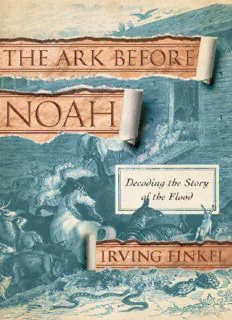
The Ark Before Noah: Decoding the Story of the Flood PDF
Preview The Ark Before Noah: Decoding the Story of the Flood
Copyright © 2014 by Irving Finkel All rights reserved. Published in the United States by Nan A. Talese / Doubleday, a division of Random House LLC, New York, a Penguin Random House Company. Originally published in Great Britain by Hodder & Stoughton, a Hachette UK Company, London. This edition published by arrangement with Hodder & Stoughton. www.nanatalese.com Doubleday is a registered trademark of Random House LLC. Nan A. Talese and the colophon are trademarks of Random House LLC. A portion of this work first appeared in the Daily Telegraph, London (January 2014). Jacket design by Michael J. Windsor Jacket photograph © Hulton Archive/Getty Images Library of Congress Cataloging-in-Publication Data is on file with the Library of Congress. ISBN 978-0-385-53711-7 (hardcover) ISBN 978-0-38553712-4 (eBook) v3.1 This book is dedicated, in respectful admiration, to Sir David Attenborough Our own Noah (picture acknowledgement Map) Contents Cover Title Page Copyright Dedication Map 1. About this Book 2. The Wedge between Us 3. Words and People 4. Recounting the Flood 5. The Ark Tablet 6. Flood Warning 7. The Question of Shape 8. Building the Arks 9. Life on Board 10. Babylon and Bible Floods 11. The Judaean Experience 12. What Happened to the Ark? 13. What is the Ark Tablet? 14. Conclusions: Stories and Shapes Appendix 1: Ghosts, the Soul and Reincarnation Appendix 2: Investigating the Text of Gilgamesh XI Appendix 3: Building the Ark – Technical Report Appendix 4: Reading the Ark Tablet Textual Notes to Appendix 4 Notes Bibliography Acknowlegdements Text Acknowledgements Picture Acknowledgements A Note About the Author 1 About this Book Time’s wheel runs back or stops: Potter and clay endure Robert Browning In the year 1872 one George Smith (1840–76), a former banknote AD engraver turned assistant in the British Museum, astounded the world by discovering the story of the Flood – much the same as that in the Book of Genesis – inscribed on a cuneiform tablet made of clay that had recently been excavated at far-distant Nineveh. Human behaviour, according to this new discovery, prompted the gods of Babylon to wipe out mankind through death by water, and, as in the Bible, the survival of all living things was effected at the last minute by a single man. He was to build an ark to house one male and one female of all species until the waters subsided and the world could go back to normal. For George Smith himself the discovery was, quite plainly, staggering, and it propelled him from back-room cuneiform boffin to, eventually, worldwide fame. Much arduous scholarly labour had preceded Smith’s extraordinary triumph, mind you, for his beginnings were humble. Endless months of staring into the glass cases that housed the inscriptions in the gallery resulted in Smith being ‘noticed’, and eventually he was taken on as a ‘repairer’ in the British Museum in about 1863. The young George exhibited an outstanding flair for identifying joins among the broken fragments of tablets and a positive genius for understanding cuneiform inscriptions; there can be no doubt that he was one of Assyriology’s most gifted scholars. As his abilities increased he was made Assistant to the famous Henry Creswicke Rawlinson, and put to sorting the thousands of clay tablets and fragments that had by then entered the Museum. Sir Henry (1810–95) had played an important and adventurous role in the early days of Assyriology and by this time was in charge of the cuneiform publications put out by the Trustees of the British Museum. Smith called one of his working categories Mythological tablets and, as the pile of identified material grew, he was slowly able to join fragment to fragment and piece to larger piece, gradually gaining insight into their literary content. The Flood Story that he came upon in this way proved to be but one episode within the longer narrative of the life and times of the hero Gilgamesh, whose name Smith suggested (as a reluctant makeshift) might be pronounced ‘Izdubar’. George Smith thus set under way the cosmic cuneiform jigsaw puzzle that is still in heroic progress today among those who work on the British Museum’s tablet collections. A problem that confronted him then – as it sometimes confronts others today – was that certain pieces of tablet were encrusted with a hard deposit that made reading the signs impossible. It so happened that one substantial piece which he knew was central to the ‘Izdubar’ story was partly covered with a thick, lime-like deposit that could not be removed without expert help. The Museum generally had Robert Ready standing by, a pioneer archaeological conservator who could usually work miracles, but he happened to be away for some weeks. One can only sympathise with the effect this had on George Smith, as recorded by E. A. Wallis Budge, later Keeper of Smith’s department at the Museum: Smith was constitutionally a highly nervous, sensitive man, and his irritation at Ready’s absence knew no bounds. He thought that the tablet ought to supply a very important part of the legend; and his impatience to verify his theory produced in him an almost incredible state of mental excitement, which grew greater as the days passed. At length Ready returned, and the tablet was given to him to clean. When he saw the large size of the patch of deposit, he said that he would do his best with it, was not, apparently, very sanguine as to results. A few days later, he took back the tablet, which he had succeeded in bringing into the state in which it now is, and gave it to Smith, who was then working with Rawlinson in the room above the Secretary’s Office. Smith took the tablet and began to read over the lines which Ready had brought to
Description: